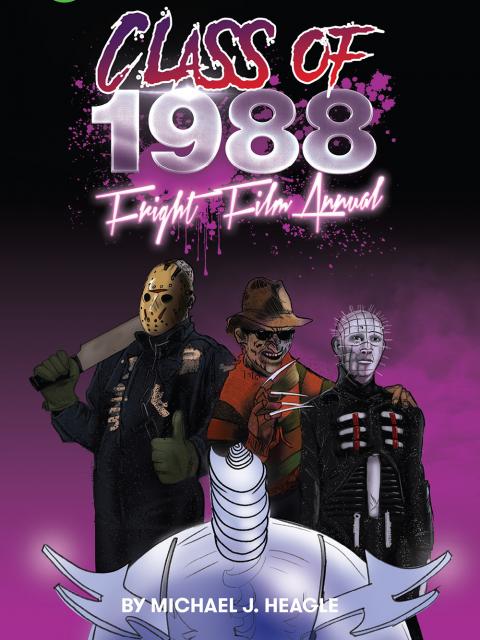Poltergeists, killer clowns, ax-wielding murderers and possessed dolls may sound like some people’s nightmares, but for University of Wisconsin-Stout’s Michael Heagle they are fodder for a fright film annual book.
Heagle, an assistant professor in entertainment design, recently self-published a new film book entitled “Class of 1988 Fright Film Annual.” Heagle honors the rubberized masks, raunch and rock and roll of the end of the 1980s when big-screen horror had gone mainstream, with popular franchises churning out numbered sequels with big budgets.
The book “captures that magic moment when horror flicks received the popular attention they deserved, and the technology of prosthetics, animatronics and gore make-up had reached a kind of zenith where make-up artists and horror actors alike could gain name recognition and a rock-star like following,” Heagle said.
In a year when many people may well be spending Halloween at home to avoid COVID-19, Heagle celebrates 40 movies with capsule reviews, synopses, budgets, box office revenues and behind-the-scenes facts. He uses a seven-stage evaluation to let fans find the exact type of movie they want most to see and help build their own 2020 quarantine watch list.
The softcover 184-page book is available on blurb.com for $13.99.
About 120 horror films came out in 1988, Heagle said. “It was a year I was just entering college, and I was starting to make my own films and so I was paying more attention, and recognizing the revival as a bigger cultural movement, with magazines, TV shows and the big budget films dominating the markets.”
For $2 Heagle, who has his Bachelor of Fine Arts in film from UW-Milwaukee and his Master of Fine Arts in animation and visual effects from the Academy of Arts University in San Francisco, could go to the local movie theater and watch and learn about his craft.
The films were violent, but most of the violence was implied and off the screen in the late 1980s, Heagle noted.

The year 1988 brought classic and cult classic films, Heagle said, noting that like classic films before them they turned the monster into the leading man.
“Child’s Play,” the first film that stars Chucky, a red-haired doll possessed by the soul of a serial killer, was released in 1988.
That same year, “Friday the 13th Part VII: The New Blood” slashed on to screens with the famous hockey-masked killer Jason Voorhees, who returns from the tomb to go on another killing spree at Crystal Lake.
The creature feature “Killer Klowns from Outer Space” was released as a science fiction, horror and comedy film. A clan of evil aliens, who resemble circus clowns, arrive on Earth and invade a small town capturing, killing and harvesting humans for sustenance.
The razor gloved-hand Freddy Krueger returned in 1988 for the fourth installment of the Nightmare on Elm Street franchise with “A Nightmare on Elm Street 4: The Dream Master.”
The fourth film in the chiller Halloween series came out with “Halloween 4: The Return of Michael Myers.”
Pinhead made his second appearance in 1988 in the gruesome “Hellbound: Hellraiser II.”
One of Heagle’s favorites from 1988 is “Phantasm II,” a science fantasy action-horror film about the Tall Man, a supernatural and malevolent undertaker who turns the dead of the Earth into dwarf zombies to be sent to his planet and used as slaves.
“I hadn’t seen the first “Phantasm” but was traumatized by the trailer at the drive-in theater when it came out in 1979,” Heagle said. “It’s this strange, nightmarish movie about collecting bodies. It is very surreal.”
The first “Phantasm” was an independent film with a lower budget. The second one had a bigger budget. “It’s very slick,” Heagle said. “The bad guy is funny. It’s done with panache and eyebrow rolling. To me, it was the right blend. A little bit of terror and plenty of laughs.”

Heagle believes people love the horror and slasher genre because, as the horror film director Wes Craven has said, it allows people to experience death.
“It is a rollercoaster of near-death experiences in a controlled environment,” Heagle said of the horror genre. “The films allow us to experience our fears from the comfort of our theater seat.”
Erik Evensen, UW-Stout associate professor and program director for the Master of Fine Arts in design, said he has been looking forward to Heagle’s book.
“Michael has an encyclopedic knowledge of 1980s media, especially what people call ‘B-culture,’ the media that never quite breaks through to the mainstream,” Evensen said. “These movies may not win awards, but they're usually full of social commentary that the mainstream won't dare to include. The villain Freddy Krueger in the "Nightmare on Elm Street" series is a manifestation of the Satanic Panic of the 1980s, and the first sequel was a famously coded exploration of homophobia during the early years of the AIDS epidemic. Michael's expertise allows him to do some serious deep dives into niche and obscure topics — he's a pop culture folklorist.”
The 1990s and the move toward computer-generated graphics helped end the 1980s slasher era, Heagle said. The new decade ushered in green screens and horror that didn’t imply gore but showed it on the screen, losing much of the magic of a real, filmed event, even if it was a rubber mask or costume.
The ability to create other worlds in film appeals to Heagle. He has been making films since he was in fifth grade, using a Super 8 camera. This year Heagle provided motion graphics for the Blu-ray release of the 1980s fantasy film “Beastmaster,” directed by his horror hero, Don Coscarelli, director of “Phantasm 2.”
Heagle is co-creator of the “Transylvania Television” show. The show is a 100% puppet cast, designed very much in the style of Jim Henson’s Muppets, but they are adult characters in an adult world. The storyline for the show is a 900-year-old vampire running a beat-down television station in Transylvania. The show can be seen on the independent streaming network Seeka.tv.
Heagle also wrote the book “Synthesizers and Saxophones: Montage Pop and Musical Movies of the 1980s,” an exploration of the relationship between 1980s pop music and movies. The totally tubular book tackles everything from movie musicals like “Purple Rain” and “Streets of Fire” to cult movies like “The Last Dragon” and “Howard the Duck.”







